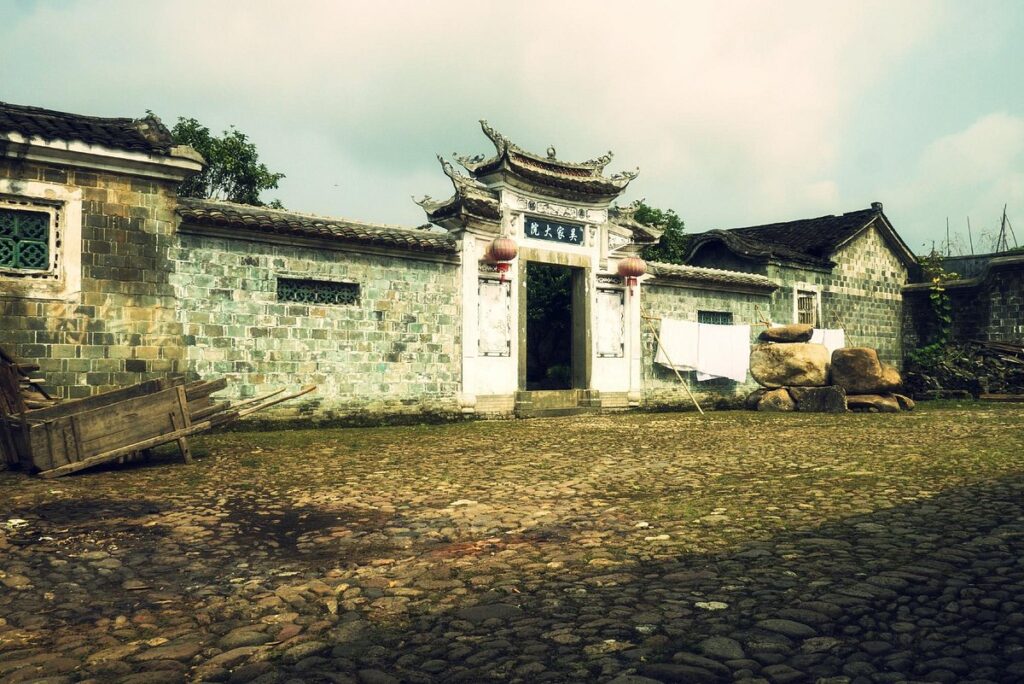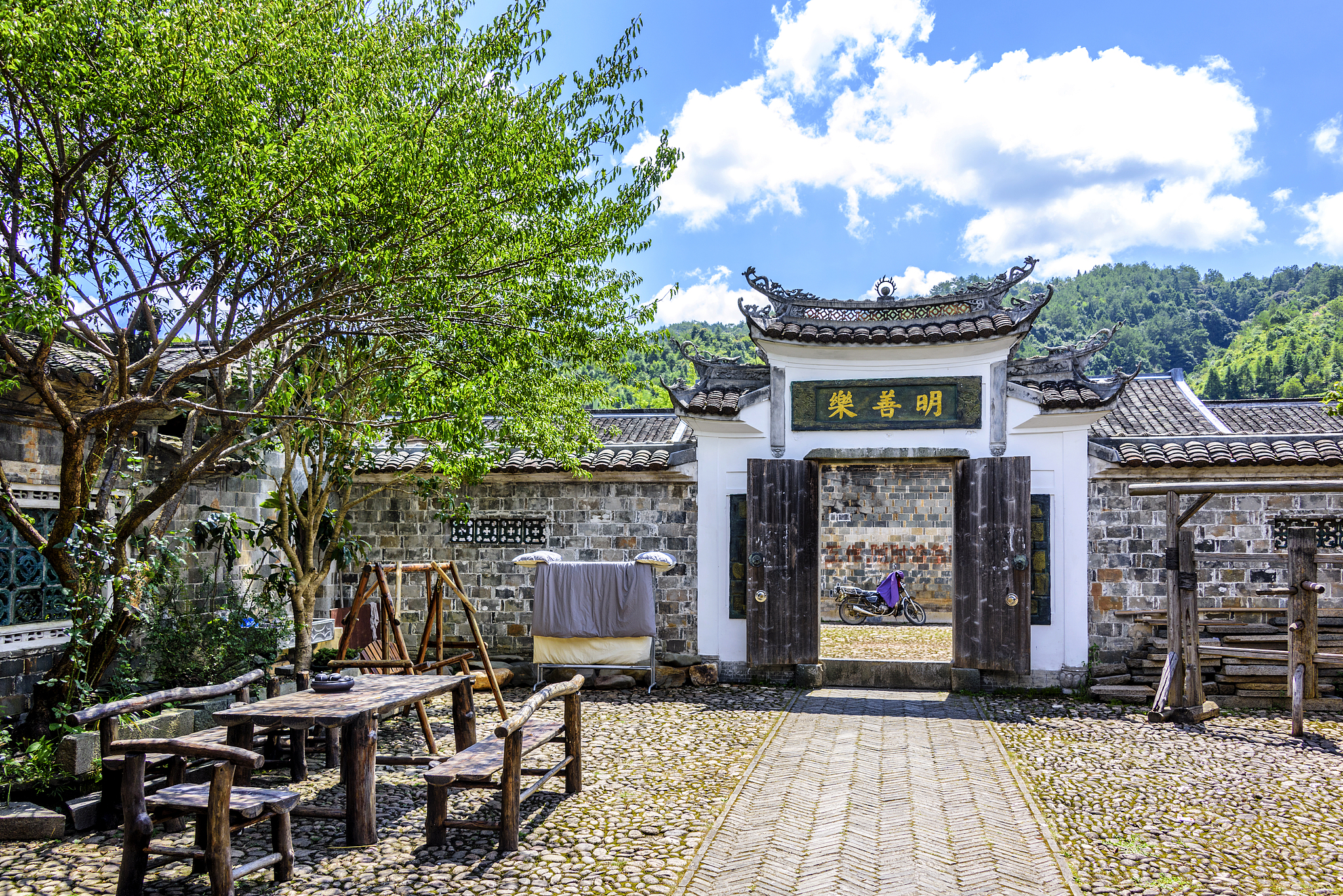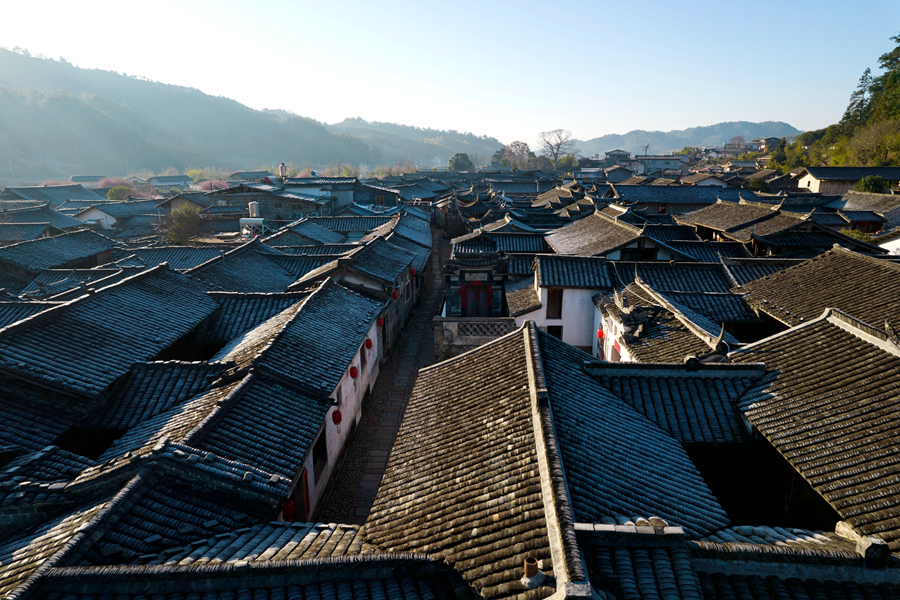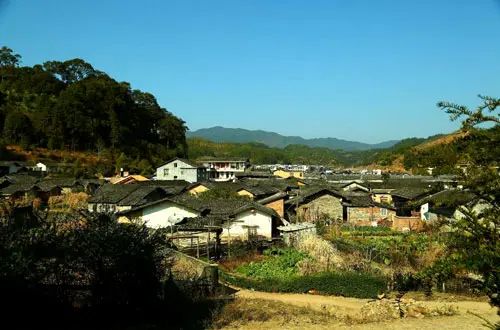Peitian Ancient Village: Your Ultimate Destination for Heritage and Scenic Beauty

An Essential Guide to Visiting Peitian Ancient Village
Nestled in the heart of Liancheng County, Peitian Ancient Village (培田古村落) offers a unique glimpse into China’s rich cultural tapestry. With its roots tracing back to the Ming Dynasty, this Hakka village is a treasure trove of history, architecture, and breathtaking scenery. Wandering through its cobbled streets, visitors are greeted by centuries-old residences that reflect the traditional way of life, interspersed with the serene beauty of the surrounding countryside.
As you explore, the charm of Peitian is not just in its well-preserved buildings but also in the warmth of its community. Here, the villagers embody the spirit of hospitality, often inviting travelers into their homes, sharing stories of the past, and offering a taste of local delicacies. This is a place where time seems to stand still, allowing you to immerse yourself in a way of life that has remained largely unchanged for generations.
Whether you’re a history buff, a photography enthusiast, or simply in search of peace away from the bustling cities, Peitian Ancient Village promises an enriching experience. Prepare to be captivated by its tranquil atmosphere, the intricate details of its architecture, and the vibrant culture that thrives within its walls. Each corner of this hidden gem tells a story, waiting for you to discover.
In This Guide
- An Essential Guide to Visiting Peitian Ancient Village
- The Rich History and Legends of Peitian Ancient Village
- Main Highlights: What You Absolutely Can’t Miss
- Planning Your Visit: A Practical Guide
- Tickets: Prices, Booking, and Tips
- How to Get There: A Complete Transportation Guide
- Local Cuisine and Accommodation Nearby
- Frequently Asked Questions
- Final Thoughts on Your Trip
The Rich History and Legends of Peitian Ancient Village
Nestled in the verdant hills of Liancheng County, Peitian Ancient Village is a captivating testament to the Hakka culture, steeped in rich history and enchanting legends that draw visitors from around the globe. This ancient village, which dates back to the Ming Dynasty, showcases a unique architectural style that reflects the resilience and ingenuity of its inhabitants.
The story of Peitian Village begins over 800 years ago when Hakka clans first settled in this picturesque location. They established the village as a safe haven during turbulent times, building sturdy homes designed to withstand invasions. The intricate earthen structures, known as tulou, are a hallmark of Hakka architecture, characterized by their circular or square shapes and communal living spaces. These buildings not only served as homes but also as fortifications, representing a blend of utility and artistry.
As visitors wander through the winding paths of Peitian, they may encounter stories of legendary figures who once walked these streets. One such tale is that of a revered scholar whose wisdom and teachings shaped the village’s educational foundations. His descendants still live in the village, preserving the traditions and values he instilled, making the village a living museum of Hakka heritage.
The village has witnessed countless changes over the centuries, yet it has retained its charm and authenticity. The sense of community remains strong, as many of the homes are interconnected, allowing families to maintain close ties. This communal spirit is evident during festivals and celebrations, where locals gather to honor their ancestors and share in the joy of their rich cultural legacy.
Peitian’s history is not merely confined to its buildings; it is also woven into the lives of the villagers. The elders, often the keepers of stories, share tales of the past, enriching the experience for travelers who seek to understand the heart and soul of the village. Their warmth and hospitality create an inviting atmosphere, allowing visitors to feel like part of the family, if only for a fleeting moment.
The legends of Peitian Village are steeped in the supernatural as well. Locals speak of spirits who watch over the village, protecting the land and its people. These stories, passed down through generations, add an air of mystique to the village, inviting travelers to contemplate the intertwining of history and folklore.
In recent years, Peitian has begun to attract more visitors, leading to efforts to preserve its unique character while catering to the needs of tourists. The local authorities are striving to maintain the balance between commercialization and authenticity, ensuring that the essence of Peitian Village remains intact for future generations.
For those seeking a deeper understanding of Hakka culture, Peitian Ancient Village offers an immersive experience that transcends time. Its rich history and captivating legends invite exploration and reflection, making it a hidden gem in the heart of China that promises unforgettable memories and a connection to the past.

Peitian Ancient Village.
Main Highlights: What You Absolutely Can’t Miss
Peitian Ancient Village is a hidden gem nestled in the lush landscapes of Liancheng County, Fujian Province. Known for its rich cultural heritage and stunning architecture, this ancient Hakka village offers visitors a unique glimpse into traditional Chinese rural life. Here are the must-see highlights that you absolutely can’t miss during your visit.
Ancient Architecture
As you stroll through the village, you’ll be enchanted by the well-preserved traditional Hakka houses, some dating back to the Ming Dynasty. The architecture is characterized by its sturdy stone walls, intricate wooden carvings, and unique layouts that reflect the communal living style of the Hakka people. Make sure to visit the Peitian Ancient Dwelling Buildings, a collection of historical homes that showcase the architectural brilliance of ancient China.
Guided Tours
To truly appreciate the depth of history and culture in Peitian, consider joining a guided tour. Knowledgeable local guides will lead you through the village, sharing fascinating stories and insights about the architecture, customs, and the lives of the villagers. Many travelers have found that without a guide, they would have missed essential details that bring the village’s history to life.
Scenic Beauty
Peitian Village is surrounded by breathtaking landscapes, making it a perfect destination for nature lovers. Wander through the verdant hills, admire the terraced fields, and take in the serene rivers that flow through the area. The tranquility of the village, combined with its picturesque scenery, provides a peaceful escape from the hustle and bustle of modern life.
Local Cuisine
Don’t miss the opportunity to savor the local Hakka cuisine while visiting Peitian. The village is known for its delicious, home-cooked meals that often feature fresh, locally sourced ingredients. Be sure to try traditional dishes like Hakka stuffed tofu and rice wine, which reflect the flavors and culture of the region. Engaging with the welcoming locals can lead to delightful culinary experiences, such as being invited to share a meal in their homes.
Cultural Immersion
Peitian is not just about sights; it’s an experience that immerses you in Hakka culture. Take the time to interact with the villagers, learn about their customs, and perhaps even participate in traditional activities. Many visitors have found their interactions with the local people to be some of the most rewarding aspects of their visit, providing a deeper understanding of the community’s way of life.
Festivals and Celebrations
If your visit coincides with local festivals, such as the Hungry Ghost Festival, you’ll be treated to vibrant displays of cultural traditions. Festivals in Peitian are lively events filled with music, dance, and food. Engaging in these festivities allows you to witness the rich cultural tapestry of the Hakka people and their enduring customs.
Time Travel Back to the Past
Walking through Peitian Village feels like stepping back in time. The ancient structures, coupled with the lack of modern distractions, allow visitors to experience a slower pace of life reminiscent of ancient China. Take your time to explore the narrow alleyways, observe the daily routines of the villagers, and soak in the atmosphere that has remained largely unchanged for centuries.
Conclusion
Peitian Ancient Village is a treasure trove of history, culture, and natural beauty. Whether you’re captivated by the stunning architecture, eager to engage with the locals, or simply seeking a peaceful retreat, Peitian offers a unique and enriching travel experience. Plan to spend at least a full day here to fully appreciate all that this enchanting village has to offer.

Peitian Ancient Village.
Planning Your Visit: A Practical Guide
Visiting Peitian Ancient Village (培田古村落) offers a unique glimpse into the rich cultural tapestry of rural China, particularly the Hakka heritage that defines this enchanting locale. To ensure that your journey is both memorable and smooth, here’s a practical guide to planning your visit.
Getting There
Peitian Village is located in Liancheng County, Fujian Province. The journey can be a bit challenging due to its remote location, but the experience is well worth it.
- By Public Transport:
- From Longyan City: Take a bus to Liancheng County, which takes approximately 2 to 3 hours. Once in Liancheng, you may need to take another bus or arrange for a taxi to reach the village.
- From Yongding County: If you’re coming from Yongding, you can take a bus to Liancheng County. Be prepared to navigate a few transfers, as public transportation may not be direct.
-
Hitchhiking: Some travelers opt to hitchhike from Pengkou Town to Peitian Village, which can be an adventurous way to meet locals.
-
By Car: If you’re driving, use GPS for navigation as the roads can be winding and less familiar. The village is accessible by newly constructed roads, but nighttime driving can be tricky due to limited street lighting.
Best Time to Visit
- Spring (March to May): The weather is mild, and the countryside bursts with greenery, making it perfect for photography and leisurely walks.
- Autumn (September to November): This season offers cooler temperatures and stunning fall foliage, providing a picturesque backdrop for your visit.
- Avoid the Hungry Ghost Festival: While this local festival can be fascinating, many shops and eateries may close, limiting food options.
Accommodation
Peitian Village offers a few guesthouses that provide a cozy stay amidst the ancient architecture. Reservations are recommended, especially during peak tourist seasons. Here are a couple of options:
- Local Guesthouses: Simple accommodations with basic amenities. Staying with a local family can enhance your experience, offering insights into daily village life.
- Hotels in Liancheng County: If you prefer more comfort, consider staying in Liancheng and making day trips to the village.
Exploring the Village
- Guided Tours: Consider hiring a local guide to enrich your experience. They can provide historical context and help you navigate the village, ensuring you don’t miss hidden gems.
- Scenic Walks: Take your time to stroll through the narrow lanes and admire the ancient Hakka architecture. The village is relatively small, and you can explore it fully in a day.
- Cultural Interactions: Engage with the villagers, many of whom are eager to share their stories and customs. Remember that some may speak only Hakka dialect, so patience is key!
What to Do
- Culinary Delights: Enjoy local Hakka cuisine, known for its flavorful dishes. Look for small eateries or ask locals for recommendations.
- Photography: Capture the beauty of the village, especially the ancient buildings and surrounding landscapes. Early morning or late afternoon light is perfect for photography.
- Local Festivals: If your visit coincides with local festivals, participate to experience authentic cultural celebrations.
Practical Tips
- Language: Basic Mandarin or a translation app can be extremely helpful, as English may not be widely spoken.
- Cash: Carry cash (RMB) as many small shops may not accept credit cards.
- Respect Local Customs: Be mindful of local traditions and practices. Dress modestly, especially when visiting homes or temples.
- Be Prepared: Facilities may be limited, so plan accordingly. Shared toilets and basic amenities are common in rural settings.
Final Thoughts
Peitian Ancient Village is a hidden gem that promises a delightful escape from the hustle of modern cities. With its rich history, stunning architecture, and warm-hearted locals, your visit will undoubtedly be an unforgettable experience. Embrace the slower pace of life here, and take the time to immerse yourself in its unique charm. Safe travels!

Peitian Ancient Village.
Tickets: Prices, Booking, and Tips
Visiting Peitian Ancient Village is like stepping back in time to a serene, rural setting steeped in Hakka culture and history. To make the most of your journey to this charming destination, here’s a detailed guide on ticket prices, booking options, and tips for a smooth visit.
Ticket Prices
As of 2023, entrance to Peitian Ancient Village is typically quite affordable, with tickets priced around RMB 30 (approximately $4.50 USD) per person. This nominal fee grants access to the village and its stunning ancient architecture, allowing you to wander through the historic streets at your leisure.
Booking Tickets
While you can usually purchase tickets directly at the entrance of the village, it’s advisable to check in advance for any changes, particularly during peak travel seasons. If you’re traveling as part of a guided tour, the cost of entry may be included in your package, so be sure to confirm with your tour provider.
Getting There
Reaching Peitian Village might require some planning, as it is located in Liancheng County, Fujian Province. The village is best accessed via public transportation. Here are some options:
- By Bus: Buses run regularly from Longyan City to Liancheng. From there, you may need to take a local bus or arrange for a taxi to reach Peitian Village. The total travel time can take around 2 to 3 hours, so be prepared for a bit of an adventure.
- By Taxi or Ride-Hailing Services: If you prefer a more direct route, consider hiring a taxi or using a ride-hailing app for a more comfortable experience, especially if you’re traveling with companions.
Tips for Your Visit
-
Consider a Guided Tour: To fully appreciate the rich history and cultural significance of Peitian Ancient Village, consider joining a guided tour. Knowledgeable guides can provide insights that you might miss while exploring on your own.
-
Stay Hydrated and Snack Smart: There are limited dining options within the village, so bring along some snacks and water. This is especially crucial if you plan to spend a longer time exploring.
-
Enjoy the Local Cuisine: If you have the chance, indulge in the local food offerings. While some eateries may be closed during certain festivals, you may find welcoming locals who are happy to share a meal with you.
-
Respect Local Customs: Peitian Village is home to a community that maintains its traditional way of life. Be respectful of their customs, and feel free to engage with the villagers if they are open to conversation.
-
Timing Your Visit: Aim for a visit during weekdays to enjoy a quieter experience. The village is less crowded, allowing you to soak in the peaceful atmosphere and take stunning photographs without the hustle and bustle.
-
Stay Overnight: If your schedule allows, consider staying overnight in one of the local guesthouses. This will give you a chance to experience the village at dawn and dusk, when the scenery is particularly enchanting.
By preparing in advance and embracing the local culture, your visit to Peitian Ancient Village promises to be a memorable adventure filled with rich history and warm hospitality. Enjoy your journey!
How to Get There: A Complete Transportation Guide
Reaching Peitian Ancient Village, a hidden gem nestled in Liancheng County, can seem like a challenge due to its rural location. However, with a bit of planning and the right mode of transport, you can enjoy a stress-free journey to this picturesque destination. Here’s a comprehensive guide to getting there.
Getting to Liancheng County
1. By Air:
The nearest major airport to Peitian Village is in Xiamen, which is approximately 250 kilometers away. From Xiamen Gaoqi International Airport, you can take a domestic flight to Longyan Airport. Longyan Airport is around 80 kilometers from Peitian Village.
2. By Train:
Longyan City is accessible via high-speed trains from major cities like Xiamen, Fuzhou, and Guangzhou. Once you arrive at Longyan Railway Station, you will need to transfer to a bus or taxi to continue your journey to Peitian.
3. By Bus:
Longyan City also has a central bus station with frequent bus services from various locations, including Xiamen and Fuzhou. If you prefer a direct route, take a bus from Xiamen or Fuzhou to Liancheng County.
From Longyan to Peitian Village
1. By Bus:
After reaching Longyan, head to the Longyan Bus Station. Look for buses heading to Liancheng County. The ride typically takes about 1.5 to 2 hours. It’s advisable to check the bus schedule in advance, as services may vary throughout the day.
2. By Taxi or Ride-Hailing Apps:
For a more direct and convenient option, you can take a taxi from Longyan City directly to Peitian Village. This will cost more but saves you time. Alternatively, use ride-hailing apps like Didi Chuxing, which are widely used in China.
Arriving in Liancheng County
Once you arrive in Liancheng County, you might find that public transport options to Peitian Village are limited. Here’s how to navigate your final leg:
1. Local Bus to Peitian:
Check if there are local buses that head toward Peitian Village. However, services may be infrequent, so be prepared for a wait.
2. Hitchhiking or Local Transport:
A popular method among travelers is to hitchhike or ask locals for a ride. Many are friendly and willing to help. Expect to pay around RMB 20-30 for a short ride to the village.
Tips for a Smooth Journey
- Language Barrier: English is not widely spoken in rural areas. A translation app or a phrasebook can be very helpful.
- Cash is King: Ensure you have enough cash on hand, as many local transport options may not accept cards or mobile payments.
- Travel Light: The village is not equipped for heavy luggage. A backpack with essentials will make moving around easier.
- Plan Ahead: Check the bus schedules and transportation routes in advance, especially if you’re traveling during holidays or weekends, when services may be reduced.
With this guide, you’re well on your way to experiencing the charm and tranquility of Peitian Ancient Village. Enjoy your travels!

Peitian Ancient Village.
Local Cuisine and Accommodation Nearby
Exploring Peitian Ancient Village not only immerses you in its rich Hakka culture and stunning architecture, but it also provides a wonderful opportunity to savor local cuisine and experience authentic accommodations that reflect the village’s historical charm.
Local Cuisine
When it comes to food, Peitian Village offers a delightful taste of Hakka culinary traditions. As you wander the village, you’ll find small family-run eateries that serve homemade dishes. Here are a few local specialties you should try:
-
Hakka Stir-Fried Vegetables: Freshly picked vegetables stir-fried with garlic and local spices. These dishes are often prepared with vegetables sourced from nearby farms, ensuring freshness.
-
Stuffed Tofu: A Hakka favorite, this dish features tofu filled with minced meat, herbs, and spices, then steamed or fried to perfection.
-
Braised Pork: Slow-cooked pork belly flavored with soy sauce and spices, served with rice. This dish is a staple in Hakka cuisine and is beloved by locals and visitors alike.
-
Rice Noodles: A comforting bowl of rice noodles served in a savory broth, often garnished with fresh herbs and vegetables.
While many eateries may close during local festivals, such as the Hungry Ghost Festival, locals are often welcoming and may invite you into their homes for a meal. This creates a unique and intimate dining experience that you won’t forget. Be sure to engage with your hosts to learn more about the dishes and their significance in Hakka culture.
Accommodations
For a truly immersive experience, consider staying in one of the local guesthouses or homestays. Here are some recommended options:
-
Peitian Ancient Village Guesthouse: This charming guesthouse offers comfortable rooms with traditional decor, providing a glimpse into the village’s history. The hosts are known for their warm hospitality and can prepare local meals upon request.
-
Hakka Homestay: Experience the daily life of a Hakka family by staying in their home. These homestays often come with home-cooked meals and the chance to learn about Hakka customs and traditions firsthand.
-
Liancheng County Hotels: If you prefer more modern amenities, several hotels in nearby Liancheng County cater to international travelers. Look for options that offer a blend of comfort and local flavor, ensuring you still feel connected to the region.
Whether you choose to dine in a local eatery or enjoy a meal prepared by your hosts, the food and accommodations near Peitian Ancient Village will enhance your travel experience and create lasting memories of this enchanting destination.

Peitian Ancient Village.
Frequently Asked Questions
Frequently Asked Questions
1. How do I get to Peitian Ancient Village?
Getting to Peitian Ancient Village can be a bit of an adventure! Most travelers recommend taking a bus to Liancheng County from Longyan City. Once in Liancheng, you may need to hitch a ride or take a local taxi to the village, as public transport options can be limited. Make sure to have a translation app handy, as English is not widely spoken in the area.
2. What is the best time to visit Peitian Ancient Village?
The ideal time to visit is during spring (March to May) and autumn (September to November), when the weather is mild and the scenery is particularly beautiful. The village is also less crowded during these seasons, allowing you to enjoy a more peaceful experience.
3. Are there guided tours available?
Yes! Guided tours are highly recommended, as they provide valuable insights into the village’s rich history and culture. Local guides can help you discover hidden gems within the village and share fascinating stories that you might otherwise miss.
4. What should I wear while exploring the village?
Comfortable, breathable clothing and sturdy walking shoes are ideal, especially if you plan to stroll through the village and surrounding countryside. The terrain can be uneven, so be prepared for a bit of walking!
5. Is there accommodation available in Peitian Village?
Yes, there are a few guesthouses and homestays in and around the village. Staying overnight can enhance your experience, allowing you to soak in the tranquil atmosphere and interact with the friendly locals.
6. What kind of food can I expect in Peitian Village?
Peitian offers traditional Hakka cuisine, which features a variety of hearty and flavorful dishes. Be sure to try local specialties, but keep in mind that some eateries may have limited hours, so it’s a good idea to check ahead or ask locals for recommendations.
7. Are there any cultural customs I should be aware of?
As a rural village with a rich cultural heritage, it’s important to be respectful of local customs. Always greet villagers politely, and if invited into a home, it’s customary to express your gratitude. Also, take care to keep noise levels down, especially in the presence of elderly residents.
8. Is Peitian Village suitable for families with children?
Absolutely! Peitian Ancient Village can be a fascinating and educational experience for children. They’ll enjoy exploring the ancient architecture and interacting with the locals. However, parents should keep an eye on their kids, as the village can have uneven paths and limited facilities.
Final Thoughts on Your Trip
As your journey comes to a close, Peitian Ancient Village leaves you with more than just memories; it offers a glimpse into the heart and soul of rural China. This hidden gem, with its winding alleys and centuries-old architecture, is a serene escape from the hustle and bustle of modern life. Here, you can witness the enduring spirit of the Hakka culture, where tradition lives on through the stories of the villagers and the beauty of the landscape.
Take a moment to reflect on the warmth and hospitality that the locals have shown. Whether it’s sharing a meal in a family home or engaging in friendly conversation, the connections made here are a testament to the kindness that resides in even the smallest of communities. As you stroll through the village, remember to savor not just the sights but also the sounds—the laughter of children, the crackling of firecrackers, and the gentle rustle of leaves in the breeze.
Visiting Peitian is not just a trip; it’s an experience that highlights the essence of humanity, reminding us of our shared values and the importance of community. So as you depart, carry with you the spirit of Peitian, and let it inspire your future travels. May every journey be as enriching and transformative as this one, encouraging you to seek out the hidden wonders of the world, where every corner holds a story waiting to be told. Safe travels!